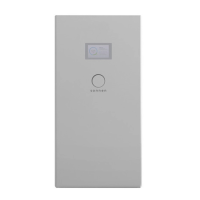
Do you have a question about the Sonnen eco Gen 3.1 Series and is the answer not in the manual?
Defines the intended readers of the manual, including installers and electricians.
Explanation of symbols, important information, and warning levels used.
Guidelines for correct usage and restrictions to prevent hazards.
Essential safety practices, PPE, and regulatory compliance.
Fire hazards and actions, battery module handling.
Key technical details of the battery modules.
Technical data including grid integration, AC/battery specs, and warranty.
Details on output, capacity, and dimensions for different eco models.
Visual representation of physical sizes for different models.
Identification of major internal parts like the Hub board and inverter.
Environmental conditions and precautions for safe storage.
Requirements for shipping hazardous battery materials and detecting transit damage.
Procedures for checking battery modules for damage after transport.
Safety guidelines and tilt limits for moving the unit.
List of necessary tools and overview of installation procedure.
Criteria for selecting an appropriate installation site.
Check for damage or loose parts before mounting.
Steps and safety warnings for physically installing the unit.
Securing the cabinet and opening its access panels.
Procedure to remove the front panel for electrical access.
Steps for electrically connecting main and battery cabinets.
Guidance on fitting protective edge guards.
Connecting grounding strap and positioning conduits for wiring.
Information on conduit entry locations and recommended cable gauges.
Step-by-step guide to removing the access panel cover.
Critical warnings about shock, burns, and fire hazards during electrical work.
Identification of ports and indicators on the battery module.
Meaning of status and power LEDs on the battery module.
Overview of the Hub board and its optional wiring features.
Instructions for AC cable connections with critical safety alerts.
Installing disconnects, running cables, stripping wires.
Verifying transfer switch function and routing cables.
Steps for connecting micro-grid L1, L2, and Neutral wires.
Connecting grid L1, L2, Neutral, and checking continuity.
How to connect ground wires to the DIN rail.
Instructions for connecting a generator with associated warnings.
Location and connection of the Ethernet port.
Options for wiring generator autostart (12V, 24V signals).
Wiring instructions for dry contact signals.
Installing and wiring an emergency stop switch.
Mounting and connecting CTs for PV metering.
Wiring the CT output signals to the terminal blocks.
Unpacking, labeling, and initial placement of battery modules.
General guidance on installing modules and mounting brackets.
Different configurations for arranging modules based on model.
Steps for securing modules using screws and brackets.
Installing set screws and horizontal bus bars for connections.
Details on arranging bus bars for different module counts.
Connecting jumper cables with terminal spacers.
Connecting homerun cables with terminal spacers.
Procedure for installing and torquing flange nuts.
Connecting communication ports and daisy-chaining modules.
Verifying DC connections and parallel battery setup.
Procedure to test AC wiring for neutral loops.
Reinstalling access/dead front panels and checking load panel isolation.
Marks the start of the system commissioning phase.
Steps to turn on battery modules and the main DC breaker.
Locating and operating the DC breaker and pre-charge switch.
Accessing the unit via web portal and logging in.
Installing updates and configuring location/time.
Configuring PV system power and generator autostart parameters.
Setting up time-of-use parameters for cost optimization.
Setting times for microgrid charging during outages.
Setup and configuration of production and consumption meters.
Entering details for the owner and installer.
Selecting mode and adjusting backup reserve.
Checking CT readings against portal data.
Final checks to ensure all system aspects are operational.
How to access and log into the sonnen web portal.
Connecting the system to the internet via router setup.
Explanation of the main overview screen elements.
Interpreting the status view for power flow and indicators.
Using overlays and selecting timeframes in the history view.
Displaying historical data over a week.
Using the cursor to view detailed data points.
Analyzing graphs for PV production, consumption, and battery state.
Finding the storage unit and logging into its interface.
Choosing between Manual, Backup, Self-Consumption, and Time of Use modes.
Adjusting backup reserve and grid charging permissions.
Setting times for microgrid charging during outages.
Accessing information for troubleshooting.
Procedures for normal and emergency shutdown.
Steps to turn off individual battery modules.
Information on compliance and disposal.
Safety precautions for handling modules for return.
Checking system messages and operational status.
Guidelines for cleaning and inspecting the storage unit.
Information on labels for ECO5 and ECO10 models.
Lists fuse types for 4kW and 8kW models.
Procedures for turning the system on and emergency shutdown.
Diagrams of terminal blocks for grid and microgrid connections.
Definitions of key terms used in the manual.
Quantities of parts needed for battery installation across models.
Imperial and metric torque settings for connections.
Provides the URL for the latest warranty details.